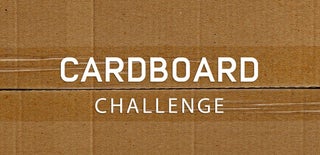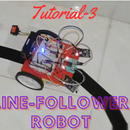Introduction: Furniture for Kids
I love kids very much. Because they are the future. They have the curiosity for discover anything. So, child caring is very important thing. So we will need to choose the materials suited for children for their use. I saw so-many items for kids, which are smaller than the original model. For an example consider a chair. For kids there are small scale models. So, here I made a round table and some stools for kids. I believed that it is very good and comfort for kids. here I made it by using the cardboard. Because it is low cost and simple to get. But it is strong enough for kids. But it has a small life period. But that is not a problem. Because children are interested in new thinks for a small period of time. So it is very suitable for children character. After its usage period it is not produce any pollution for our great earth. The plastic furniture make big problems for our earth. So this cardboard furniture vanish the pollution from our great earth. So I made it for a good and happy future. Please support me to save our mother earth...
SAVE EARTH
Step 1: Materials
The main material used is the cardboard. These are obtained for free from any shop. Because it is used to make the cover for products to protect them. So it is available for free. Then for some art work, I use some color papers. The detailed list is given below,
- Cardboard
- Color paper (very thin)
- Fevicol glue (SH) - 500 ml
- Flux kwik (instant adhesive)
Images are given above.
Step 2: Tools
Here I use some common tools for it's work. The main tools are the paper cutting knife and small metal ruler. The detailed list is given below. But for your work, you choose your right tools depend on your favor.
- Paper cutting knife
- Small metal ruler
- Shaving blade
Tools images are given above.
Step 3: Full Plan
Here I made a small table and some stools as the children furniture. These are the main furniture needed for the children for their work. They will like it very much. Its shape is little bit different from ordinary stools and table. Because children like new variety designs. I got this design from google search. But that is made by using wood. Here I made it by using cardboard. Now you think that, it is hard enough for furniture? Yes, of-course; it is hard enough for children. I use some special techniques for hardening it.
The reference image is shown above.
The full making process is divided into two parts. First table making and then the stool making. OK. So lets start it...
Step 4: Preparing the Cardboard
Here in this step, I cut the cardboard boxes into rectangular sheets. Because the cardboard boxes have some bending portions, this portion is not hard enough. So we remove this portions and prepare good sheets of cardboard for further use. The procedure given below,
- Open the boxes by removing the sticky tapes
- Cut it into rectangular sheets bu using small cutter and the metal ruler
- Use the paper cutter with care
- Clean the edges of the cardboard
- Sort it based on the size
Step 5: PART 1- Table Making
This is the first part of this project. Here we made the table from cardboard. The finished table images given above. In this part first made the table top portion and then the table legs. The following steps explain, how it is made? I use table color as orange and red. You choose your favorite colors. It is a medium sized table. It is suitable for kids. So now we going to next steps for explain the making procedure.
Step 6: Cutting the Table Top
First we going to make the table top. Here I made it from joining different cardboard portions. Because i don't have a larger piece. If you have larger cardboard sheets you make it from the single card board piece. The cutting dimensions are given in the above images. The procedure is given below,
- Select suitable cardboard sheets
- Draw the cutting lines as the dimension given in the image
- Cut through the lines by using a paper cutter (knife)
- Clean its cutting edges
- Ensure that it forms a perfect circle
Step 7: Cardboard Reinforcement
The cardboard is not a hard material. So now we going to reinforce it to increase the strength. For this process, I use the flux kwick. The flux kwick is an instant adhesive. It is very hard when it is dry. So it is reinforce the cardboard very well.
- Apply the flux kwick through the holes in the cardboard
- Repeat this process from two sides of the holes
- Wait for drying
- Remove the excess adhesive from the edges by using a sand paper
IMP: Flux kwick is danger, keep it away from children and use it as safe as possible
Step 8: Glue It Together (Top Part)
The cardboard sheets are glued together to form the round shaped table top. For the gluing process, I use the fevicol adhesive. It is commonly used for wood process. the procedure given below,
- Clean the cardboard edges
- Apply fevicol at the cardboard edges
- Join the cardboard pieces and clip it together by using paper clips or apply some weight above it
- Wait for drying it
Step 9: Add Second Layer
For strengthening we use some reinforcement techniques. For additional hardness we going to add a second layer of cardboard to the first finished layer. It used to increase the thickness of the table top. Here the second layer is add in the opposite orientation (holes) arrangement to the first layer. That is, it is in the arrangement that, the vertical holes in the first layer is perpendicular to the vertical holes in the second layer. It will doubles the strength. For this layer, we don't cut the cardboard pieces into circle shape. Glue it in an order-less manner and finally cut it into the first-layer shape. The detailed procedure given below,
- Select useful pieces for second layer
- Apply fevicol to two surfaces
- Glue the first layer and second layer together
- Apply some weight above it to glue it together very well
- Wait for drying it
- Cut the second layer with respect to the first layer using the cutter
- Finish the ends to make perfect circle
Step 10: Locking Mechanism
Here we make the locking mechanism to join the table legs and the table top. For this we make some rectangular holes (grooves) to the bottom side of the table top. It's dimension is given in the above image. Ensure that the holes do not penetrate to the top side. The procedure given below,
- Select the good surface as the top side and other one as bottom side
- Draw the plan to the bottom side using pen and ruler (seen in image)
- Make grooves (rectangular) at the shaded portion by using cutter
- Clean it
Step 11: Finishing the Table Top
Here we add some color paper to the table top to increase the beauty. It act as a paint for the table. I use a red colored paper for it. It is glued to the cardboard by using the fevicol. here use a two layers of color paper. Procedure is given below,
- Smooth the top surface using a sand paper (4000
- Apply fevicol to the entire cardboard
- The fevicol distribution is uniformed by using a small ruler (also decrease the fevicol thickness)
- Apply the color paper to it (avoid air bubbles in it)
- Wait for drying
- Apply second cote of color paper
- Wait for drying
- Cut the excess color paper from sides
- Glue the color paper to the edges
Finishes the table top work.
Step 12: Cutting Table Base
Here we cut the cardboard for the table base or the table legs. The dimensions are given in the above images. We need two pieces of this dimension. If you have a large sheet of cardboard then you cut it from the single piece. Here we also done the reinforcement process.
- Select the suitable cardboard sheets
- Cut it into the shape with the given dimension
- Clean and finish the edges
- Apply flux kwick to the holes to reinforce the cardboard
- Wait for drying
- Finish the edges using sand paper
Step 13: Glue It Together
It is time for joining it together. It is done in the same manner as done in the previous steps. It is done for the two structures.
- Apply fevicol to the two joining edges of cardboard
- Glue it together
- Apply some weight above it to dry it in the correct shape
- Apply some paper clip to keep it in position
- Wait for drying
Step 14: Apply Second Layer
Here we add second layer to the first layer to increase the thickness and there by increase the strength of the cardboard. The orientation arrangement of the two layer are done in the same manner as done in the previous step (in table top). This done for the two structures. Procedure given below,
- Select suitable cardboard
- Apply fevicol to two surfaces and glue it together
- Apply some heavy weight above it to ensure that they are join together very well
- Cut the edges with respect to the first layer
- Finish and clean the edges
Step 15: Join the Legs
In this step we going to join the legs together to form the base of the table. The images show above explain the full procedure. One base structure is divide into two pieces and it is penetrate into the holes in the other piece to join it together. Then apply some glue to fix it in its position. The dimension of holes are given above. procedure given below,
- Take the two leg structures
- Draw the drawing shown in the above images in two structures
- Cut one structure into two pieces which shown in above image
- Remove the shaded portion by using the cutter
- Finish the holes which shown in the image
- Join it together by using the fevicol adhesive
- Wait for drying it
Step 16: Apply Color Coating
Here we apply color paper to the table base to increase its beauty. I use orange colored paper. Before the color paper apply, make some rectangular shape above the table base for connecting it to the table top. It is given in the above image. Its dimension is made which is suitable for the grooves which is made in the table top in the previous steps. The procedure is given below,
- Make rectangular shapes above the table base which is suitable for the grooves made in the table top
- Apply fevicol to the base sides
- Thin the fevicol layer by using a small metal ruler
- Place the color paper above it without making air bubbles
- Done it for the 8 sides
- Cut the unwanted color paper from sides
- Glue the extended paper to the side cutting
Step 17: Second Layer Paper
Here we add an extra second layer paper to finish the table base. It is done in the same manner as done before. Now the color is increased to a good orange color.
Step 18: Final Finish for Table
In this step we done some art work to increase the beauty of the table. Here we glue some white colored paper in the edges of table base and table top. It increase the beauty. The procedure given below,
- Take white colored paper
- Apply fevicol on the edges
- Place the white paper on the edges
- Apply second layer of the white paper
- Cut the excess whitepaper from the edges in precision using the shaving blade
- Wait for drying it
Step 19: Table Assembly
It is the last step for table making. Here the top part and the base part are glued together to form the table. The bottom part is pushed into the grooves in the top part and apply some adhesive to fix it. The procedure is given below,
- Apply fevicol to the grooves in the table top
- Apply fevicol to the base part rectangular structures
- Push and lock the bottom part to the grooves in the table top
- Apply heavy weight to the table to fix it in the correct position
- Wait for drying it
Our table making is successfully finishes.
Step 20: PART 2 - Stool Making
In this step we make the stools using cardboard. This stool design is similar to the table design. This stool is made by the same procedures which are done for making the table. So, lets discover it....
Step 21: Stool Part Cutting
The stool top is a one fourth of a circle. The base part is same shape as the table base. The dimensions are given in the above image. The circle is made by using a thread and marker. The procedure is given below,
- Select good cardboard
- Draw the plan in the cardboard using marker as shown in the above image
- Cut it through the markings by using the cutter
- Finish and clean the edges
Step 22: Strengthening
For strengthening, we use the previous reinforcement by glue and the double cardboard method. the two layer of cardboard are arranged in opposite orientation by the hole. This will increase the strength. the procedure is shown below,
- Apply some flux kwick to the holes in the cardboard for strengthening
- Wait for dry it
- Apply fevicol on the sides of the prepared cardboard
- Glue the cardboard together
- Apply a weight to fix the cardboard in its position
The above procedures are done for the stool base and the stool top side.
Step 23: Making the Base
In this step the base cardboard are jointed by using lock setup to make the stool base. The lock system cutting plan is given in the above figure. Then it is cut and glued together. The complete procedure is given below,
- Draw the cutting plan into the card board by using markers and the ruler
- Remove the shaded region by using the cutter
- Clean and finish the edges
- Apply the fevicol to the cuttings
- Push the to parts together and lock it is in the holes
- Ensure that the two cardboard pieces make a 90 degree
- Wait for drying it
Step 24: Making the Top and Base Locking Mechanism
Here use the same procedure which used in the table joining process. Here make grooves at the stool top piece and the rectangular shaped structure made at the stool base piece.
- Draw the cutting plan in the cardboard
- Using the cutter remove the shaded portion
- Ensure that at the top piece do not make hole only make groove
- Ensure that the two pieces join perfectly
- Apply same procedure for rest of the stools
Step 25: Finishing the Stool Top
Here in this step we apply the color paper above the stool top to increase the beauty. The process is done by the same procedure done for the table top. The color is the same color used in the table top (red). procedures given below,
- Clean and smooth the stool surface by using sand paper (400)
- Apply a thin coat of fevicol in the stool top
- Glue the red color paper to the stool top (avoid the air bubbles)
- Cut the extra lengths of color paper
- Glue the excess color paper to the side cutting
- Wait for drying it
Step 26: Apply Color Coating
In this step we going to apply the color coating to the base of the stool. Here I use the green color paper. You choose your favorite color. Here apply to layer of the color paper. It is done by the same procedure done at the table making.
- Clean and smooth the surfaces using sandpaper
- Apply a thin coat of fevicol to the cardboard
- Glue the color paper to it (avoid air bubbles)
- Cutting the paper for the base size and excess portion glued to the side cutting
- This repeat for the rest of the sides and rest of the stools
- Wait for drying it
- After drying, apply a second coat of color paper to it
- Wait for drying it
Step 27: Final Finishing
In this step we provide some art work to the stool which is done before in the table. That is to apply a white color coating to the edges of the stool top and stool base. This will increase the beauty of the stool. Procedure is given below,
- Apply a thin layer of fevicol to the edges of the stool base and stool top
- Stick the white colored paper ti it in a double layer
- Remove the excess paper from the edges by using a shaving blade
- Wait for drying it
Step 28: Stool Assembly
It is the final step in the stool making. In this step we connect the stool top and bottom together. It is done same manner which done in the table assembly.
- Apply fevicol to the grooves(holes) in the stool top
- Apply fevicol to the rectangular shaped structures in the stool base
- Push the stool base into the hole in the stool top
- Apply some weight on the stool top for keeping it in the correct position
Finally we done the stool making successfully.
Step 29: Stool Images
These are some stool images.
Step 30: Final Result
This images are our result for work. I believed that it is awesome. Are you like it? Please comment me.
Step 31: Saving the Nature
After completing the work. There remain a lot of cardboard pieces. I don't waste it. I use it to save the earth by saving a plant. In the summer season, we add a layer of mulch around the plants helps keep the moisture in the soil from evaporating too fast. Here I use the small pieces of cardboard to make the layer to keep the moister soil. It is a very good use of the waste cardboard sheets.
- Take the waste cardboard pieces
- Shredding it by using fingers
- Make a layer around the plant
SAVE EARTH

Participated in the
Cardboard Challenge











